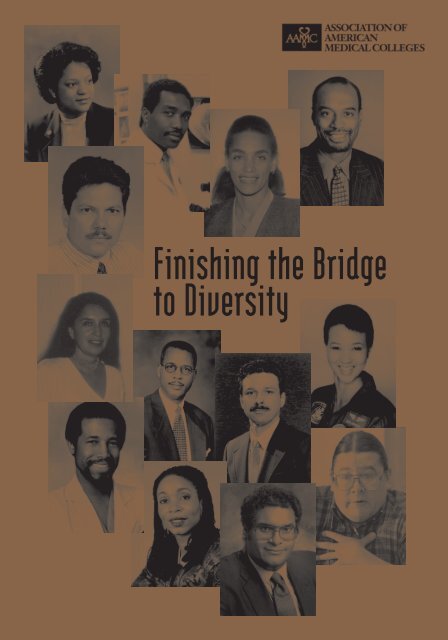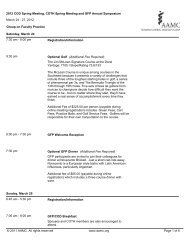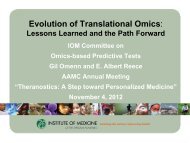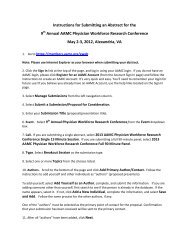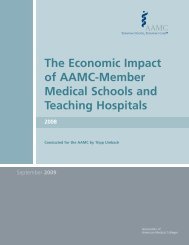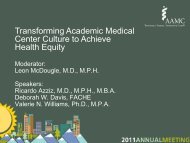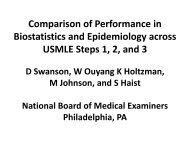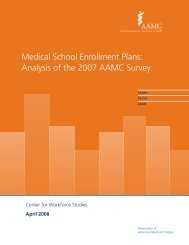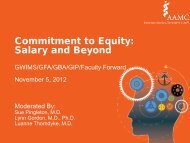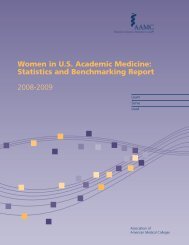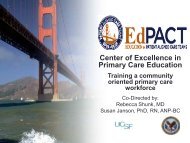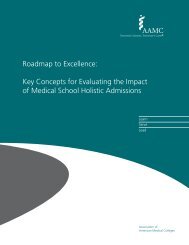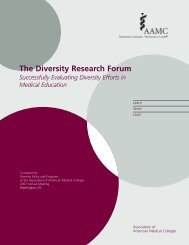Finishing the Bridge to Diversity - Member Profile - AAMC
Finishing the Bridge to Diversity - Member Profile - AAMC
Finishing the Bridge to Diversity - Member Profile - AAMC
Create successful ePaper yourself
Turn your PDF publications into a flip-book with our unique Google optimized e-Paper software.
<strong>Finishing</strong> <strong>the</strong> <strong>Bridge</strong><br />
<strong>to</strong> <strong>Diversity</strong>
1<br />
5<br />
6<br />
10<br />
2 4<br />
3<br />
9<br />
7<br />
8<br />
11<br />
13<br />
12<br />
1. Regina M. Benjamin, M.D., M.B.A., solo practitioner<br />
in Bayou La Batre, Alabama; member American<br />
Medical Association Board of Trustees<br />
2. Griffin P. Rodgers, M.D., Chief, Molecular Hema<strong>to</strong>logy,<br />
National Institute of Diabetes and Digestive and<br />
Kidney Diseases, National Institutes of Health<br />
3. Patrice Desvigne-Nickens, M.D., Direc<strong>to</strong>r, Heart<br />
Research Program, National Institutes of Health<br />
4. Mark D. Smith, M.D., M.B.A., President and Chief<br />
Executive Officer, California HealthCare Foundation<br />
5. Samuel M. Aguayo, M.D., F.A.C.P., F.C.C.P., Associate<br />
Chief of Staff/Education, Atlanta Veterans Affairs<br />
Medical Center, and Associate Professor of Medicine,<br />
Emory University School of Medicine<br />
6. Melvina McCabe, M.D., Associate Professor, Department<br />
of Family and Community Medicine, University of<br />
New Mexico School of Medicine<br />
7. Reed V. Tuckson, M.D., President, Charles R. Drew<br />
University of Medicine and Science<br />
8. Herbert W. Nickens, M.D., Vice President of<br />
Community and Minority Programs<br />
9. Mae C. Jemison, M.D., President, <strong>the</strong> Jemison Group;<br />
former NASA astronaut<br />
10. Benjamin S. Carson, M.D., Direc<strong>to</strong>r, Pediatric<br />
Neurosurgery, Johns Hopkins Medical Institutions<br />
11. Helene D. Gayle, M.D., M.P.H., Direc<strong>to</strong>r, National<br />
Center for HIV, STD, and TB Prevention, Centers<br />
for Disease Control and Prevention (CDC)<br />
12, Woodrow A. Myers, Jr., M.D., M.B.A., Direc<strong>to</strong>r, Health<br />
Care Management, Ford Mo<strong>to</strong>r Company<br />
13. Walter B. Hollow, M.D., Direc<strong>to</strong>r, Native American<br />
Center of Excellence, University of Washing<strong>to</strong>n<br />
School of Medicine<br />
This is a slightly edited version of <strong>the</strong> President’s Address presented November 8,<br />
1996 at <strong>the</strong> Plenary Session of <strong>the</strong> 107th Annual Meeting of <strong>the</strong> Association of<br />
American Medical Colleges (<strong>AAMC</strong>), held in San Francisco, November 6-12, 1996.<br />
Dr. Cohen is president of <strong>the</strong> <strong>AAMC</strong>, Washing<strong>to</strong>n, D.C.<br />
Correspondence and requests for reprints should be addressed <strong>to</strong> <strong>the</strong> Office of<br />
<strong>the</strong> President at <strong>the</strong> <strong>AAMC</strong>, 2450 N Streeet, NW, Washing<strong>to</strong>n, DC 20037-1127.
1965 Residency Class, Harvard University School of Medicine
<strong>Finishing</strong> <strong>the</strong> <strong>Bridge</strong> <strong>to</strong> <strong>Diversity</strong><br />
<strong>Finishing</strong> <strong>the</strong> <strong>Bridge</strong> <strong>to</strong> <strong>Diversity</strong><br />
Jordan J. Cohen, M.D.<br />
I want <strong>to</strong> call you all <strong>to</strong> action.<br />
To take firm leadership on this<br />
issue. Leadership in educating<br />
<strong>the</strong> best doc<strong>to</strong>rs. Leadership in<br />
providing quality health care.<br />
And leadership in finding answers<br />
<strong>to</strong> major health problems.<br />
FFor my part <strong>to</strong>day, I have chosen <strong>to</strong> discuss a more longstanding challenge.<br />
One that has been with us much longer than ei<strong>the</strong>r managed care or Web<br />
pages. I want <strong>to</strong> talk about finishing <strong>the</strong> bridge <strong>to</strong> diversity. This bridge-building<br />
challenge differs a lot, I think, from o<strong>the</strong>rs that are commanding so much of<br />
our attention. For one thing, although <strong>the</strong> <strong>to</strong>ols we need for this work stem,<br />
as always, from carefully honed analyses of <strong>the</strong> data, those <strong>to</strong>ols must be<br />
sharpened for this particular task by something in addition <strong>to</strong> data — by<br />
deeply felt passion.<br />
My plan is <strong>to</strong> set forth <strong>the</strong> reasons why I think achieving diversity in<br />
medicine is so critical. I want <strong>to</strong> call your attention <strong>to</strong> some his<strong>to</strong>rical arguments,<br />
some practical arguments, and some moral arguments. In <strong>the</strong> end, I<br />
want <strong>to</strong> call you all <strong>to</strong> action. To take firm leadership on this issue. Leadership<br />
in educating <strong>the</strong> best doc<strong>to</strong>rs. Leadership in providing quality health care.<br />
And leadership in finding answers <strong>to</strong> major health problems. None of <strong>the</strong>se<br />
goals can be achieved, in my judgment, without taking leadership <strong>to</strong> bridge<br />
<strong>the</strong> appalling diversity gap that still separates medicine from <strong>the</strong> society it<br />
professes <strong>to</strong> serve.<br />
1
<strong>Finishing</strong> <strong>the</strong> <strong>Bridge</strong> <strong>to</strong> <strong>Diversity</strong><br />
The Challenge for Academic Medicine<br />
To establish <strong>the</strong> context for my remarks, let me review some familiar<br />
facts. The population of <strong>the</strong> United States continues <strong>to</strong> grow and will do so<br />
well in<strong>to</strong> <strong>the</strong> next century (Figure 1). The truly dramatic change <strong>to</strong> come,<br />
however, is not <strong>the</strong> size<br />
Millions<br />
500<br />
400<br />
300<br />
200<br />
100<br />
Growth of US Population<br />
Today<br />
0<br />
1950 1970 1990 2010 2030 2050<br />
YEAR<br />
of our population but its<br />
composition. Our population<br />
is growing older,<br />
as every one knows, and<br />
it also is growing racially<br />
and ethnically more<br />
diverse (Figure 2).<br />
Minority populations are<br />
increasing much more<br />
rapidly in this country<br />
than is <strong>the</strong> majority white<br />
population. As shown in<br />
Figure 2, between 1980<br />
and 1995, while our<br />
country’s white population<br />
Figure 1. Growth and projected growth<br />
of <strong>the</strong> U.S. population, 1950-2050.<br />
grew by about<br />
12%, our black<br />
population<br />
increased twice<br />
as fast, by<br />
about 24%;<br />
our Native<br />
American population<br />
grew<br />
by 57%; our<br />
Hispanic population,<br />
by 83%;<br />
and our Asian<br />
population, by<br />
more than<br />
Percent<br />
200<br />
150<br />
100<br />
50<br />
0<br />
Recent Growth in Subgroups<br />
of US Population<br />
12%<br />
24%<br />
57%<br />
83%<br />
160%<br />
White Black Native Hispanic Asian<br />
American<br />
Figure 2. Increases, in percentages, of subgroups of <strong>the</strong> U.S. population, 1980-1995.<br />
2
<strong>Finishing</strong> <strong>the</strong> <strong>Bridge</strong> <strong>to</strong> <strong>Diversity</strong><br />
160%. The result, as<br />
shown in Figure 3, is<br />
that somewhere in <strong>the</strong><br />
middle of <strong>the</strong> next century,<br />
<strong>the</strong> majority of our<br />
citizens will be members<br />
of minority groups.<br />
So what What do<br />
<strong>the</strong>se striking demographic<br />
trends describing <strong>the</strong><br />
future complexion of<br />
America have <strong>to</strong> do with<br />
our responsibilities as<br />
stewards of medicine’s<br />
future I find <strong>the</strong> answer<br />
<strong>to</strong> that question pretty<br />
straightforward. Academic<br />
medicine is, after all, largely<br />
about <strong>the</strong> future. It’s about<br />
Percent<br />
100<br />
80<br />
60<br />
40<br />
20<br />
The Future Complexion<br />
of America<br />
0<br />
1980 1990 2000 2010 2020 2030 2040 2050<br />
YEAR<br />
improving <strong>the</strong> health of future generations by educating <strong>the</strong> physicians who<br />
will care for <strong>to</strong>morrow’s children, and by discovering better ways <strong>to</strong> keep<br />
<strong>to</strong>morrow’s children healthy. Given that our primary obligation <strong>to</strong> society is <strong>to</strong><br />
furnish it with a physician workforce appropriate <strong>to</strong> its needs, our mandate is<br />
<strong>to</strong> select and prepare students for <strong>the</strong> profession who, in <strong>the</strong> aggregate, bear a<br />
reasonable resemblance <strong>to</strong> <strong>the</strong> racial, ethnic, and of course, gender profiles of<br />
<strong>the</strong> people <strong>the</strong>y<br />
will serve. In<br />
Academic medicine is, after all, largely about <strong>the</strong> future. It’s about<br />
o<strong>the</strong>r words, a<br />
improving <strong>the</strong> health of future generations by educating <strong>the</strong> physicians<br />
medical profession<br />
that looks<br />
who will care for <strong>to</strong>morrow’s children, and by discovering better ways<br />
like America. We <strong>to</strong> keep <strong>to</strong>morrow’s children healthy.<br />
have made substantial<br />
progress on this front with respect <strong>to</strong> gender; but, as <strong>the</strong>se data suggest,<br />
we’ve still got a long, long way <strong>to</strong> go with respect <strong>to</strong> race and ethnicity.<br />
But why should anyone care if <strong>the</strong> medical profession reflects society’s<br />
racial and ethnic makeup as long as we have plenty of well-trained practitioners<br />
of whatever background The reasons are many. Let me mention five that<br />
stand out in my mind:<br />
Asian<br />
Hispanic<br />
Native<br />
American<br />
Black<br />
White<br />
Figure 3. Changes and projected changes in <strong>the</strong> relative sizes of five racial-ethnic groups in <strong>the</strong><br />
U.S. population, 1980-2050.<br />
3
<strong>Finishing</strong> <strong>the</strong> <strong>Bridge</strong> <strong>to</strong> <strong>Diversity</strong><br />
Achieving Justice and Equity<br />
First is <strong>the</strong> simple matter of justice and equity. The medical profession,<br />
and <strong>the</strong> health professions in general, occupy a lofty status in American society,<br />
and offer those who pursue <strong>the</strong>m many of <strong>the</strong> most challenging and rewarding<br />
career opportunities available anywhere. As physicians, for us <strong>to</strong> seek justice<br />
within our own profession is, I believe, only <strong>to</strong> be faithful <strong>to</strong> our cardinal<br />
commitment <strong>to</strong> respect everyone’s individuality equally.<br />
Ensuring Access <strong>to</strong> Health Care<br />
The second reason is a matter of improved access <strong>to</strong> health care for <strong>the</strong><br />
underserved. Abundant data now exist <strong>to</strong> document unequivocally that black,<br />
Hispanic, and native American physicians are much more likely than whites and<br />
Asians <strong>to</strong> practice in underserved communities. Not that minority physicians<br />
are, or should be, under any obligation <strong>to</strong> do so; not that minority physicians<br />
are not, and should not be, free <strong>to</strong> settle and practice wherever and however<br />
<strong>the</strong>y choose; and not that o<strong>the</strong>r physicians do not contribute importantly <strong>to</strong><br />
improving access among <strong>the</strong> underserved. The simple fact is that minority<br />
physicians do so with greater predictability. And getting <strong>the</strong> job done means<br />
producing more minority physicians <strong>to</strong> lead <strong>the</strong> way.<br />
Providing Culturally Competent Care<br />
The third reason for increasing diversity among our students — and<br />
faculty, I might add — has <strong>to</strong> do with learning how <strong>to</strong> deliver culturally competent<br />
care. Given <strong>the</strong><br />
expanding<br />
Learning how <strong>to</strong> deliver culturally competent care means learning<br />
diversity<br />
medicine with students and from faculty who are <strong>the</strong>mselves emblematic<br />
throughout our<br />
of society’s diversity. Textbooks alone just won’t cut it.<br />
society, all<br />
physicians of<br />
<strong>the</strong> future will need this essential skill, and must be given a strong foundation<br />
in what it means <strong>to</strong> deliver culturally competent care.<br />
If <strong>the</strong>y are truly <strong>to</strong> care for <strong>the</strong>ir diverse patients, physicians of whatever<br />
background must have a firm grasp on how various belief systems, cultural<br />
biases, family structures, his<strong>to</strong>rical realities, and a host of o<strong>the</strong>r culturally<br />
determined fac<strong>to</strong>rs influence <strong>the</strong> way people experience illness and <strong>the</strong> way<br />
<strong>the</strong>y respond <strong>to</strong> advice and treatment. Such differences are real and translate<br />
in<strong>to</strong> real differences in <strong>the</strong> outcomes of care. But should you find this argument<br />
unconvincing, let me remind you of a pragmatic consideration — of <strong>the</strong><br />
4
<strong>Finishing</strong> <strong>the</strong> <strong>Bridge</strong> <strong>to</strong> <strong>Diversity</strong><br />
increasing importance of cus<strong>to</strong>mer satisfaction. As our patients become culturally<br />
more diverse, our ability <strong>to</strong> meet <strong>the</strong>ir culturally determined expectations will<br />
strongly influence <strong>the</strong>ir choice of caregivers. The connection between all of<br />
this and <strong>the</strong> need <strong>to</strong> expand diversity in <strong>the</strong> educational environment is clear.<br />
Learning how <strong>to</strong> deliver culturally competent care means learning medicine<br />
with students and from faculty who are <strong>the</strong>mselves emblematic of society’s<br />
diversity. Textbooks alone just won’t cut it.<br />
Setting an Appropriately Comprehensive Research Agenda<br />
A fourth reason for addressing diversity has <strong>to</strong> do with our research<br />
agenda. Our society as a whole is plagued by many unsolved health problems,<br />
many of which swirl disproportionately around our minority populations. Our<br />
country’s research agenda is set in large measure by those who have chosen<br />
careers in investigation. Individual investiga<strong>to</strong>rs, in turn, tend <strong>to</strong> do research<br />
on problems that <strong>the</strong>y “see” and have an interest in. And what people see, and<br />
what tickles <strong>the</strong>ir fancy, depends <strong>to</strong> a great extent on <strong>the</strong>ir particular cultural<br />
and ethnic filters. Recognizing all <strong>the</strong>se truths leads <strong>to</strong> <strong>the</strong> reality that finding<br />
solutions <strong>to</strong> our country’s most recalcitrant health problems, even being able<br />
<strong>to</strong> conceptualize what <strong>the</strong> real problems actually are, will require a research<br />
workforce that is much more diverse racially, ethnically, and by gender than<br />
we now have. Creating that workforce begins with ensuring diversity among<br />
those admitted <strong>to</strong> our M.D. and Ph.D. educational programs.<br />
Securing <strong>the</strong> Talent Needed To Lead <strong>the</strong> Health Care Enterprise<br />
in<strong>to</strong> <strong>the</strong> Twenty-first Century<br />
My fifth and final reason for <strong>the</strong> need <strong>to</strong> achieve diversity in <strong>the</strong> medical<br />
profession relates <strong>to</strong> management of <strong>the</strong> health care system. Physicians must<br />
continue <strong>to</strong> exert leadership — some would say re-exert leadership — in <strong>the</strong><br />
management of <strong>the</strong> health care enterprise, especially now that that enterprise<br />
is becoming<br />
increasingly We must draw <strong>the</strong> future physician leadership for our health care<br />
corporatized. systems... from a richly diverse pool of talent, adequately reflecting<br />
But assuming our country’s gender, racial, and ethnic mélange. It’s simply smart<br />
management<br />
business <strong>to</strong> do so.<br />
responsibility<br />
for a system destined <strong>to</strong> serve <strong>the</strong> health care needs of an increasingly diverse<br />
people is a job that can only be done well by equally diverse management<br />
teams. We must draw <strong>the</strong> future physician leadership for our health care sys-<br />
5
<strong>Finishing</strong> <strong>the</strong> <strong>Bridge</strong> <strong>to</strong> <strong>Diversity</strong><br />
Percent<br />
15<br />
12<br />
9<br />
6<br />
3<br />
0<br />
tems — as we must for all o<strong>the</strong>r<br />
professional and non-professional<br />
sec<strong>to</strong>rs of <strong>the</strong> American economy<br />
— from a richly diverse pool of talent,<br />
adequately reflecting our<br />
country’s gender, racial, and ethnic<br />
mélange. It’s simply smart business<br />
<strong>to</strong> do so.<br />
So, five reasons stand out for<br />
seeking diversity in <strong>the</strong> medical<br />
profession: achieving justice and<br />
equity; ensuring access <strong>to</strong> health<br />
care; providing culturally competent<br />
care; setting an appropriately comprehensive research agenda; and<br />
securing <strong>the</strong> talent needed <strong>to</strong> lead <strong>the</strong> health care enterprise in<strong>to</strong> <strong>the</strong> twentyfirst<br />
century.<br />
Taking a His<strong>to</strong>rical Look<br />
How are we doing Let’s take a his<strong>to</strong>rical look. Until <strong>the</strong> mid 1960s or<br />
so, <strong>the</strong> racial — and, of course, gender — composition of medical school classes,<br />
and hence of <strong>the</strong> medical<br />
Underrepresented Minorities<br />
US Population vs Medical School Matriculants<br />
% URMs in US Population<br />
1966<br />
1964<br />
1962<br />
1960<br />
1958<br />
1956<br />
1954<br />
1952<br />
1950<br />
% URM Matriculants<br />
YEAR<br />
Figure 4. The era before affirmative action: percentages of underrepresented minorities<br />
(URMs) in <strong>the</strong> U.S. population and as matriculants in medical schools, 1950-1966.<br />
Seeking <strong>Diversity</strong> in <strong>the</strong> Medical<br />
Profession Will Help Achieve:<br />
• Just and equitable access <strong>to</strong> rewarding careers<br />
• Improved access <strong>to</strong> health care for <strong>the</strong><br />
underserved<br />
• Culturally competent care<br />
• A comprehensive research agenda<br />
• Use of <strong>the</strong> rich and diverse pool of <strong>the</strong> nation’s<br />
talent <strong>to</strong> better manage <strong>the</strong> health care system.<br />
profession, was composed,<br />
mono<strong>to</strong>nously, of white men.<br />
As shown in Figure 4, despite<br />
a progressively expanding,<br />
double-digit presence in our<br />
population, groups that we<br />
now designate as underrepresented<br />
minorities made up<br />
only about 2% of medical<br />
school matriculants, and<br />
three-quarters of those<br />
attended ei<strong>the</strong>r Howard or<br />
Meharry. The typical medical<br />
school of that era admitted<br />
one minority student every<br />
o<strong>the</strong>r year. I graduated from<br />
medical school in 1960, one<br />
of <strong>the</strong> off years. In my class of<br />
6
<strong>Finishing</strong> <strong>the</strong> <strong>Bridge</strong> <strong>to</strong> <strong>Diversity</strong><br />
140, <strong>the</strong>re were 134 white men and six white women. And that was a banner<br />
year for women.<br />
In my 1965 residency class, <strong>the</strong>re were no women (except nurses), no blacks,<br />
no Hispanics, no Native Americans, not even an Asian American. Racial segregation<br />
was as fully evident in medicine as it was in virtually every sec<strong>to</strong>r of<br />
American society,<br />
just as it had In my 1965 residency class, <strong>the</strong>re were no women, no blacks, no Hispanics,<br />
been for many<br />
no Native Americans, not even an Asian American. Racial segregation<br />
preceding<br />
was as fully evident in medicine as it was in virtually every sec<strong>to</strong>r of<br />
decades. But<br />
things began <strong>to</strong><br />
American society, just as it had been for many preceding decades.<br />
change in <strong>the</strong><br />
late 1960s. The civil rights movement, <strong>the</strong> assassination of Martin Lu<strong>the</strong>r King,<br />
and a rash of urban riots woke many people up. And academic medicine was<br />
among <strong>the</strong> first <strong>to</strong> get <strong>the</strong> wake-up call. The result was a dramatic rise in <strong>the</strong><br />
admission of minorities <strong>to</strong> medical schools (Figure 5). Although not shown in<br />
Figure 5, women also began <strong>to</strong> matriculate in record numbers. Was this because<br />
scores on <strong>the</strong> Scholastic Aptitude Test, grade-point averages, and Medical College<br />
Admission Test scores of women and minority students suddenly began <strong>to</strong><br />
skyrocket. Of course not. What changed — what led <strong>to</strong> <strong>the</strong> dramatic rise in<br />
women and minority matriculants <strong>to</strong> medical school — was simply that academic<br />
medicine began <strong>to</strong> take affirmative<br />
actions <strong>to</strong> increase <strong>the</strong><br />
racial, ethnic, and gender<br />
diversity of medical school<br />
classes.<br />
As shown in Figure 5,<br />
enrollment of underrepresented<br />
minorities in U.S.<br />
medical schools rose rapidly<br />
<strong>to</strong> about 8% of all matriculants<br />
by <strong>the</strong> early 1970s. But,<br />
as you can see, progress on<br />
our bridge <strong>to</strong> diversity stalled<br />
in <strong>the</strong> mid 1970s, with admissions<br />
remaining virtually flat<br />
for <strong>the</strong> next 15 years or so.<br />
To make matters worse, <strong>the</strong><br />
fraction of individuals from<br />
<strong>the</strong> same groups in <strong>the</strong> U.S.<br />
population that were under-<br />
Percent<br />
20<br />
15<br />
10<br />
5<br />
0<br />
1950<br />
The ’60s Wake Up Call<br />
% URM Matriculants<br />
1955<br />
1960<br />
% URMs in US Population<br />
1965<br />
1970<br />
YEAR<br />
Figure 5. Early success of affirmative action: percentages of underrepresented minorities<br />
(URMs) in <strong>the</strong> U.S. population and as matriculants in medical schools, 1950-1990, showing<br />
a sharp increase in <strong>the</strong> late 1960s as a result of affirmative actions.<br />
1975<br />
1980<br />
1985<br />
1990<br />
7
<strong>Finishing</strong> <strong>the</strong> <strong>Bridge</strong> <strong>to</strong> <strong>Diversity</strong><br />
represented in medicine continued <strong>to</strong> grow during this period, as shown in<br />
<strong>the</strong> <strong>to</strong>p line in Figure 5, increasing from 16% in 1975 <strong>to</strong> 19% in 1990. Our<br />
bridge <strong>to</strong> diversity, in o<strong>the</strong>r words, was less than halfway across <strong>the</strong> chasm,<br />
and <strong>the</strong> gap was widening under our eyes. Clearly it was time <strong>to</strong> call in <strong>the</strong><br />
engineers <strong>to</strong> reevaluate our bridge-building strategy. We did so, and <strong>the</strong> result<br />
was Project 3000 by 2000.<br />
Creating Partnerships<br />
When Bob Petersdorf announced this important initiative at <strong>the</strong> 1991<br />
meeting of this association just five years ago, he noted that <strong>the</strong> root cause of<br />
minority underrepresentation in medical schools in <strong>the</strong> present era is <strong>the</strong><br />
accumulated academic disadvantages borne by <strong>to</strong>o many minority young<br />
people simply because <strong>the</strong>y lack access <strong>to</strong> high-quality, precollege and college<br />
educations. As a consequence, groups of applicants from <strong>the</strong> various and<br />
diverse sec<strong>to</strong>rs of our population do not arrive at our admission offices with<br />
equivalent academic credentials. Clearly, <strong>the</strong> only satisfac<strong>to</strong>ry fix for this dilemma<br />
in <strong>the</strong> long run is fundamental reform of our country’s education system.<br />
And that is <strong>the</strong> core mission of Project 3000 by 2000: <strong>to</strong> contribute what<br />
we can — in concert with a host of o<strong>the</strong>r public and private initiatives — <strong>to</strong><br />
<strong>the</strong> long-term solution for a very complex, multifac<strong>to</strong>rial, recalcitrant social<br />
catastrophe. As you know, <strong>the</strong> Project’s core strategy is <strong>to</strong> effect small-scale<br />
educational reform through<br />
durable, minority-focused community<br />
partnerships, partnerships<br />
among academic medical centers<br />
and those K-12 school systems and<br />
colleges that are responsible for <strong>the</strong><br />
academic preparation of potential<br />
underrepresented minority applicants.<br />
This is <strong>the</strong> novel element of<br />
<strong>the</strong> Project’s strategy: To create<br />
honest-<strong>to</strong>-God partnerships with<br />
selected feeder schools that will<br />
complement and reinforce <strong>the</strong> many<br />
useful approaches undertaken for<br />
years by many in <strong>the</strong> academic<br />
medicine community.<br />
Special programs, including<br />
magnet health science high schools,<br />
articulation agreements, and science<br />
Project 3000 by 2000<br />
Mission Statement<br />
To eliminate <strong>the</strong> underrepresentation of blacks,<br />
Native Americans, Mexican Americans, and Mainland<br />
Puer<strong>to</strong> Ricans in U.S. medical schools.<br />
Core Strategy<br />
To effect small-scale educational reform through durable,<br />
minority-focused partnerships of academic medical<br />
centers and those K-12 school systems and colleges<br />
that are responsible for <strong>the</strong> academic preparation of<br />
potential applicants from underrepresented minorities.<br />
Examples of What Works<br />
• Magnet health science high schools<br />
• Articulation agreements with feeder colleges<br />
• Science education partnerships<br />
• Early identification and fostering of interest and<br />
talent<br />
• Relationships with men<strong>to</strong>rs<br />
8
<strong>Finishing</strong> <strong>the</strong> <strong>Bridge</strong> <strong>to</strong> <strong>Diversity</strong><br />
education partnerships have been created <strong>to</strong> identify promising students early<br />
in <strong>the</strong> educational pipeline, <strong>to</strong> enrich <strong>the</strong> science and related offerings available<br />
<strong>to</strong> students<br />
from poorly This is <strong>the</strong> novel element of <strong>the</strong> Project’s strategy: To create honest-<strong>to</strong>equipped<br />
schools,<br />
God partnerships with selected feeder schools that will complement and<br />
<strong>to</strong> establish men<strong>to</strong>ring<br />
relation-<br />
reinforce <strong>the</strong> many useful approaches undertaken for years by many<br />
ships <strong>to</strong> keep <strong>the</strong> in <strong>the</strong> academic medicine community.<br />
flames of inquiry<br />
and aspiration burning intensely, and <strong>to</strong> provide adequate counseling <strong>to</strong> ensure<br />
that all <strong>the</strong> miles<strong>to</strong>nes on <strong>the</strong> long road <strong>to</strong> medical school are unders<strong>to</strong>od and met.<br />
What happened after <strong>the</strong> launch of Project 3000 by 2000 What happened<br />
was a second dramatic upturn in <strong>the</strong> number of underrepresented minorities<br />
admitted <strong>to</strong> medical school (Figure 6). Indeed, <strong>the</strong> number began <strong>to</strong> rise almost<br />
immediately and tracked right along <strong>the</strong> trajec<strong>to</strong>ry <strong>to</strong>ward <strong>the</strong> Project’s numerical<br />
goal of 3,000 new entrants <strong>to</strong> medical school among underrepresented groups<br />
by <strong>the</strong> turn of <strong>the</strong> century. In 1994, for <strong>the</strong> first time in his<strong>to</strong>ry, more than<br />
2,000 underrepresented minority students entered medical school, up from<br />
fewer than 1,500 in 1990.<br />
But how is this possible I just got through saying that Project 3000 by<br />
2000 was aiming at <strong>the</strong> long haul. How did it achieve such early success I<br />
think one reason, for sure, was <strong>the</strong> new attention focused by <strong>the</strong> Project on <strong>the</strong><br />
Percent<br />
25<br />
Project 3000 by 2000<br />
20<br />
15<br />
10<br />
% URMs in US Population<br />
% URM Matriculant<br />
1,470<br />
Matriculants<br />
2,014<br />
Matriculants<br />
12%<br />
10%<br />
5<br />
0<br />
1988 1990 1992 1994<br />
YEAR<br />
1970<br />
1966<br />
1962<br />
1958<br />
1954<br />
1950<br />
1994<br />
1990<br />
1986<br />
1982<br />
1978<br />
1974<br />
Figure 6. Temporary rise in <strong>the</strong> percentage of underrepresented minorities (URMs) who were matriculated in medical<br />
schools from 1990-1994. This upswing was partly due <strong>to</strong> increased attention that <strong>the</strong> launching of Project 3000 by 2000<br />
(shown by circle) focused on <strong>the</strong> lack of adequate racial and ethnic diversity among medical students.<br />
9
<strong>Finishing</strong> <strong>the</strong> <strong>Bridge</strong> <strong>to</strong> <strong>Diversity</strong><br />
lack of adequate racial and ethnic diversity among medical students. As a result,<br />
we saw a significant increase in <strong>the</strong> fraction of underrepresented minority<br />
applicants who gained acceptance at virtually every school. As it happens, we<br />
also got a boost from <strong>the</strong> rising tide of applicants during this same period; <strong>the</strong><br />
pool of minority applicants rose along with <strong>the</strong> pool of all applicants. Call it<br />
<strong>the</strong> Hawthorne effect if you like, but, in fact, <strong>the</strong> measurable progress made<br />
during this phase validated, once again, <strong>the</strong> power of affirmative action.<br />
Standing <strong>the</strong> Test<br />
The next critically important question <strong>to</strong> address, and one that <strong>the</strong> critics<br />
of affirmative action raise repeatedly, is whe<strong>the</strong>r <strong>the</strong> use of affirmative action as<br />
a <strong>to</strong>ol, and <strong>the</strong> resulting increase in <strong>the</strong> number of minority medical students,<br />
leads <strong>to</strong> unqualified individuals becoming doc<strong>to</strong>rs. To raise such a question is<br />
<strong>to</strong> concede ignorance of <strong>the</strong> facts. First of all, no one in <strong>the</strong>ir right mind would<br />
argue for admitting anyone <strong>to</strong> medical school who did not evidence <strong>the</strong> academic<br />
skills and personal<br />
No one in <strong>the</strong>ir right mind would argue for admitting anyone <strong>to</strong><br />
qualities necessary<br />
for completing<br />
medical school who did not evidence <strong>the</strong> academic skills and personal<br />
<strong>the</strong> M.D. degree.<br />
qualities necessary for completing <strong>the</strong> M.D. degree.<br />
Such an admission<br />
policy would not<br />
only violate our oath <strong>to</strong> patients, it would be a disastrous disservice <strong>to</strong> individual<br />
students. And <strong>the</strong> data clearly show that medical schools are keen <strong>to</strong> avoid this<br />
pitfall.<br />
The vast majority of medical students from underrepresented minority<br />
groups, as is true of all students admitted <strong>to</strong> medical school, do successfully<br />
complete <strong>the</strong> rigorous requirements for graduation. Medical school admission<br />
committees cannot be commended enough for <strong>the</strong> care <strong>the</strong>y take in selecting<br />
our country’s future physicians. That only a handful of students from all backgrounds,<br />
majority and minority alike, prove unable <strong>to</strong> withstand <strong>the</strong> rigors —<br />
or <strong>to</strong> meet <strong>the</strong> financial costs — of a medical education and must abandon <strong>the</strong><br />
quest along <strong>the</strong> line, is ample testimony <strong>to</strong> <strong>the</strong> skill and wisdom of our admission<br />
committees.<br />
But let’s return <strong>to</strong> <strong>the</strong> data for some less happy news. What is now evident,<br />
unfortunately, is that <strong>the</strong> initial upturn in <strong>the</strong> admission of underrepresented<br />
minorities following <strong>the</strong> launch of Project 3000 by 2000 leveled off in 1995,<br />
and, even more alarmingly, actually fell — by more than 100 individuals —<br />
among this year’s matriculants (Figure 7). After <strong>the</strong> his<strong>to</strong>ric high of 1994,<br />
something changed. Has Project 3000 by 2000 run out of steam Quite <strong>the</strong><br />
10
<strong>Finishing</strong> <strong>the</strong> <strong>Bridge</strong> <strong>to</strong> <strong>Diversity</strong><br />
Percent<br />
25<br />
Our <strong>Bridge</strong> <strong>to</strong> <strong>Diversity</strong> is Sagging<br />
20<br />
15<br />
10<br />
% URMs in US Population<br />
% URM Matriculants<br />
2,014 URM<br />
Matriculants<br />
1,906 URM<br />
Matriculants<br />
12%<br />
10%<br />
5<br />
1972<br />
1968<br />
1964<br />
1960<br />
1956<br />
1952<br />
1996<br />
1992<br />
1988<br />
1984<br />
1980<br />
1976<br />
0<br />
1990 1992 1994 1996<br />
YEAR<br />
Figure 7. The bridge <strong>to</strong> diversity is sagging. The initial upturn in <strong>the</strong> admission of underrpresented minorities (URMs) following<br />
<strong>the</strong> launch of Project 3000 by 2000 leveled off in 1995 and <strong>the</strong>n fell by more than 100 individuals in 1996. This downturn<br />
was partly due <strong>to</strong> weakened, and sometimes blocked, affirmative actions.<br />
contrary. We learn of more and more educational partnerships and effective<br />
programs every year. As I’ve tried <strong>to</strong> emphasize, Project 3000 by 2000 is aimed<br />
at <strong>the</strong> long haul. The returns it will have on <strong>the</strong> investments it makes in educational<br />
partnerships will accumulate slowly over <strong>the</strong> next several years, even<br />
decades. It will take at least that long <strong>to</strong> fix <strong>the</strong> pipeline, <strong>to</strong> release us from <strong>the</strong><br />
need for short-term remedies.<br />
And it’s precisely those short-term remedies that may well be in jeopardy.<br />
What may be running out of steam, in o<strong>the</strong>r words, is <strong>the</strong> oomph behind affirmative<br />
action programs, programs designed <strong>to</strong> reach out not only <strong>to</strong> those<br />
qualified young people from underrepresented minority groups who are<br />
already in <strong>the</strong> applicant pool, but also <strong>to</strong> those who should be in <strong>the</strong> pool, and<br />
<strong>to</strong> those who, through short-term academic enrichment efforts, could qualify<br />
<strong>to</strong> enter <strong>the</strong> pool. The reason for being suspicious that weakened affirmative<br />
action efforts may be <strong>the</strong> culprit here is all <strong>to</strong>o obvious, given <strong>the</strong> way its use is<br />
being attacked on so many fronts.<br />
Chilling Conclusions<br />
For us in higher education, <strong>the</strong> Hopwood case was one of <strong>the</strong> most chilling<br />
pieces of evidence that affirmative action is under attack. As you know, <strong>the</strong><br />
decision of <strong>the</strong> U.S. Court of Appeals for <strong>the</strong> Fifth Circuit in that case, which<br />
11
<strong>Finishing</strong> <strong>the</strong> <strong>Bridge</strong> <strong>to</strong> <strong>Diversity</strong><br />
was let stand by <strong>the</strong> Supreme Court, has taken away <strong>the</strong> right of faculties in<br />
Texas, Mississippi, and Louisiana <strong>to</strong> use race and ethnicity at all as fac<strong>to</strong>rs in<br />
admission <strong>to</strong> any university program. And as of three days ago, with <strong>the</strong> passage<br />
of Proposition 209,<br />
our colleagues<br />
For us in higher education, <strong>the</strong> Hopwood case was one of <strong>the</strong> most<br />
here in California<br />
chilling pieces of evidence that affirmative action is under attack.<br />
are no longer<br />
free <strong>to</strong> consider<br />
race, ethnicity, or gender in admission decisions, in recruiting programs, or<br />
even in planning and implementing minority-targeted outreach activities, such<br />
as tu<strong>to</strong>ring programs and educational enrichment courses. California, Texas,<br />
Mississippi, and Louisiana: <strong>the</strong>se four states alone contain fully 35% of <strong>the</strong><br />
minority populations that remain underrepresented among medical students,<br />
and fully 75% of those from <strong>the</strong> Mexican-American community.<br />
Keeping <strong>Diversity</strong> in Academic Medicine’s Future<br />
Those who oppose affirmative action, and I know many of you do, argue<br />
ei<strong>the</strong>r that it’s no longer needed, or that it’s ineffective, or that it’s unfair. Looking<br />
at this contentious issue from <strong>the</strong> vantage point of <strong>the</strong> medical profession, I<br />
maintain that all three of those arguments are false.<br />
Is affirmative action in medical school admission still needed<br />
Absolutely. Until <strong>the</strong> academic credentials of all groups in <strong>the</strong> applicant pool<br />
are indistinguishable, we simply cannot use <strong>the</strong> same criteria <strong>to</strong> evaluate all<br />
applicants. Let me be absolutely clear. Given <strong>the</strong> disparity in available measures<br />
of academic achievement among applicants grouped by race and ethnicity, <strong>the</strong>re<br />
is simply no way<br />
We must continue, for as long as necessary, <strong>to</strong> reach out <strong>to</strong> those we can select an<br />
whose race and ethnicity, not <strong>the</strong>ir economic status alone, have adequately<br />
subjected <strong>the</strong>m <strong>to</strong> inferior academic preparations, but who, by dint diverse class of<br />
of character, intelligence, and drive, are fully prepared <strong>to</strong> succeed medical students<br />
as physicians and medical scientists.<br />
<strong>to</strong>day without<br />
taking race and<br />
ethnicity explicitly or implicitly in<strong>to</strong> account. Using surrogates for race and<br />
ethnicity can certainly help, but that approach is not an adequate substitute, in<br />
my mind, for being forthright about what is needed. We must continue, for as<br />
long as necessary, <strong>to</strong> reach out <strong>to</strong> those whose race and ethnicity, not <strong>the</strong>ir<br />
economic status alone, have subjected <strong>the</strong>m <strong>to</strong> inferior academic preparations,<br />
but who, by dint of character, intelligence, and drive, are fully prepared <strong>to</strong><br />
succeed as physicians and medical scientists.<br />
12
<strong>Finishing</strong> <strong>the</strong> <strong>Bridge</strong> <strong>to</strong> <strong>Diversity</strong><br />
Is affirmative action ineffective Certainly not in medicine. Indeed,<br />
nowhere is <strong>the</strong> effectiveness of affirmative action more in evidence than in our<br />
profession. Effective not only in narrowing our diversity gap, but effective in<br />
greatly expanding access <strong>to</strong> care.<br />
Is affirmative action unfair How in <strong>the</strong> world can it be unfair <strong>to</strong> boost<br />
<strong>the</strong> chances of becoming a physician — <strong>to</strong> give special treatment <strong>to</strong> persons<br />
who have been subjected <strong>to</strong> obscenely unfair discrimination because of <strong>the</strong>ir<br />
heritage, and whose status in our democratic society remains tarnished<br />
through no fault of <strong>the</strong>ir own. Okay, but how about being fair <strong>to</strong> all <strong>the</strong> o<strong>the</strong>r<br />
applicants who don’t get <strong>the</strong> benefits of affirmative action. Look, we have many<br />
more qualified applicants <strong>to</strong> medical school than we have places for <strong>the</strong>m.<br />
Most applicants come away empty-handed, and do so for a whole variety of<br />
reasons. To single<br />
out affirmative<br />
If one of my kids or grandkids was rejected from medical school, I’d be<br />
action for <strong>the</strong>ir<br />
damned disappointed; but if <strong>the</strong>y tried <strong>to</strong> blame it on reverse discrimination,<br />
I’d say: Get a life.<br />
disappointment<br />
and plead unfair<br />
treatment just<br />
doesn’t compute. If one of my kids or grandkids was rejected from medical<br />
school, I’d be damned disappointed; but if <strong>the</strong>y tried <strong>to</strong> blame it on reverse<br />
discrimination, I’d say: Get a life. Because I believe it’s time already <strong>to</strong> share<br />
<strong>the</strong> wealth, <strong>to</strong> recognize that our profession needs — and our country needs<br />
— <strong>the</strong> best talent it can find from every group in our society.<br />
The Call <strong>to</strong> Action<br />
As much as we’d like <strong>to</strong> think o<strong>the</strong>rwise, and as much as we long for <strong>the</strong><br />
day when it’s no longer true, race and ethnicity still matter in America. To ignore<br />
that reality in deciding who deserves <strong>to</strong> be admitted <strong>to</strong> medical school is <strong>to</strong><br />
ignore our duty as stewards of our profession’s future. I can tell you that <strong>the</strong><br />
<strong>AAMC</strong> does not intend <strong>to</strong> ignore its duty in this arena. As you may know, late<br />
last spring we spearheaded <strong>the</strong> formation of a new coalition, Health<br />
Professionals for <strong>Diversity</strong>. Over 30 of <strong>the</strong> nation’s leading medical, health, and<br />
education organizations have signed-on <strong>to</strong> this coalition, and we all have pledged<br />
<strong>to</strong> do whatever we can (1) <strong>to</strong> make <strong>the</strong> case for diversity in <strong>the</strong> healing professions,<br />
(2) <strong>to</strong> prevent <strong>the</strong> spread of anti-affirmative action initiatives, and (3) <strong>to</strong><br />
release <strong>the</strong> constraints that have already been imposed on many of our faculties.<br />
We must continue <strong>to</strong> produce physicians and scientists from all segments<br />
of America. We must remember how many young minority physicians, with<br />
<strong>the</strong>ir many talents and abundant energy, would have been lost <strong>to</strong> us if <strong>the</strong><br />
13
<strong>Finishing</strong> <strong>the</strong> <strong>Bridge</strong> <strong>to</strong> <strong>Diversity</strong><br />
enrollment practices from my era in medical school had not been reversed by<br />
affirmative action. But simply repeating <strong>the</strong> rhe<strong>to</strong>ric of <strong>the</strong> 1960s will not be<br />
enough. We must face up <strong>to</strong> <strong>the</strong> fact that our society is being hammered at<br />
present by a mean-spirited backlash. Race has once again become a political<br />
“wedge” issue. A growing fraction of our citizens seems prepared <strong>to</strong> accept <strong>the</strong><br />
views expressed by some politicians that we can abandon affirmative action<br />
efforts, that we have come far enough in undoing <strong>the</strong> ravages our society<br />
suffered during<br />
We must face up <strong>to</strong> <strong>the</strong> fact that our society is being hammered at present centuries of ugly<br />
by a mean-spirited backlash. Race has once again become a political subjugation by<br />
“wedge” issue.<br />
race, that our<br />
awful legacy of<br />
racial and ethnic discrimination is behind us. We have a judge in <strong>the</strong> Hopwood<br />
case, for example, who offers <strong>the</strong> opinion that race contributes no more <strong>to</strong> a<br />
person’s identity than does his or her blood type. One wonders what planet<br />
that judge is living on!<br />
All of us must speak out <strong>to</strong> <strong>the</strong> opinion leaders and lawmakers in our<br />
communities. This is a moral issue, and it is a health issue. Hence, it is our issue.<br />
And <strong>the</strong> data are compelling. The consequence of abandoning affirmative<br />
action programs prematurely will be a reduction in <strong>the</strong> availability, and a<br />
deterioration in <strong>the</strong> quality, of health care services for everyone.<br />
In jurisdictions like <strong>the</strong> Fifth Circuit and in California, where prohibitions<br />
have been imposed on <strong>the</strong> use of race-conscious, affirmative-action <strong>to</strong>ols, we<br />
must work within <strong>the</strong> law <strong>to</strong> minimize <strong>the</strong> impact on minority enrollments. The<br />
<strong>AAMC</strong> will seek <strong>to</strong> develop and disseminate <strong>to</strong> those states whatever lawful alternatives<br />
we can find <strong>to</strong> ensure that qualified applicants from underrepresented<br />
minority groups continue <strong>to</strong> be identified and recruited <strong>to</strong> medical schools.<br />
We must redouble our efforts on behalf of Project 3000 by 2000. We must<br />
work <strong>to</strong> accelerate <strong>the</strong> establishment of meaningful educational partnerships<br />
with pipeline schools and encourage o<strong>the</strong>rs <strong>to</strong> join in <strong>the</strong> effort. Each of us, as<br />
citizens, needs <strong>to</strong><br />
In short, medicine must stay <strong>the</strong> course, we must not be afraid <strong>to</strong> lead. see our beleaguered<br />
pubic<br />
schools as <strong>the</strong> crucibles from which our future physicians will come, and use our<br />
privileged place in American society <strong>to</strong> be advocates and champions of education.<br />
In short, medicine must stay <strong>the</strong> course. We must not be afraid <strong>to</strong> lead.<br />
We must finish <strong>the</strong> bridge <strong>to</strong> diversity we began <strong>to</strong> build in <strong>the</strong> 1960s. We<br />
cannot allow thoughtless attacks on affirmative action <strong>to</strong> dismantle <strong>the</strong> fledgling<br />
structure we have yet <strong>to</strong> complete, a structure without which at least some of<br />
our minority colleagues would never have attained <strong>the</strong>ir dreams, never have healed<br />
a patient, never have discovered new knowledge, never have led an institution,<br />
never have inspired a student, and never have graced our profession.<br />
14


